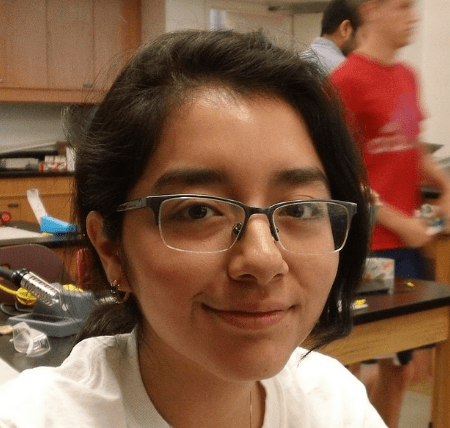Hi,
My name is Ashley. I’m a rising freshman at the University of Wisconsin-Madison. I intend to major in civil engineering and pursue environmental engineering as a career. I’d like to help the environment through the use of technology.
I’ve enjoyed my time at BlueStamp. I learned about engineering concepts in depth. Before this I had never been exposed to coding, through having to research I learned the meanings of function and am comfortable reading code. I feel reassured in my chosen major because the part that involved what my major would mostly entail, designing, was in fact my favorite part. I look forward to exploring engineering in college.
FINAL MILESTONE



Since my last milestone the arrangement of the circuit has changed. I designed a finger cuff using OnShape. This was my favorite part of the project. I really enjoy designing . The design is simple but efficient. I made it so that there was a detachable bottom. The reason for this was because I wanted to hide some of the connections and wiring to make it aesthetically more pleasing. The circuit remains the same from the one seen in my first milestone video it’s
composed of a transimpedance amplifier, high-pass filter and an AC gain stage. I moved it from a breadboard to a PCB. There were some complications with the photodiode and IR LED working together with the circuit, so some troubleshooting is needed. I soldered down the components to ensure there were no loose connections. I then found a more reliable source for the pulse sensor.
Part Studio 1.sldprt
Part Studio 2.sldprt
FIRST MILESTONE
What I first set out to do was ensure that the circuits work the way they should. I started by making sure I had all the right parts. I read over the schematics available and made sense of them. I created the transimpedance amplifier. This is a circuit that consists of an op amp, a capacitor and a resistor. It converts the current produced by the photodiode into voltage. The voltage goes through the feedback loop of the amp op. The capacitor’s role is to reduce the noise. I used a 1 Mohm resistor, the reason why being because the voltage given from the photodiode is not as strong. The resistor allows for there to be a gain. From the transimpedance amplifier we then filter out signal. I removed the low frequency signal by removing DC bias. The high-pass filter consists of a capacitor and two resistors. The capacitor in this case is used to remove low signals. The capacitor has a high resistance to low frequencies and a low resistance to high frequencies. From there the current moved onto the AC gain stage which consists of two resistors a capacitor and a non-inverting op amp. Again we use the capacitor to ensure that only high frequencies are captured. The reason why this is important is because when trying to measure someone’s pulse the photodiode is going to count the light absorbed by the tissue, however, we don’t want that.The only data it should be collecting is of pulsing arteries which will give off higher frequencies. In order to just measure the pulse we have to make sure that only high frequencies are being picked up.
STARTER PROJECT
My starter project was the Exploding Star Color Organ. I used a 9 volt battery to power this project. The sound enters the microphone. From there the current is sent to the circuit. These currents go through the transistors, which amplifies the current. They are now more capable of spreading through the rest of the circuit. From there it goes to the IC, the specific one used in this project is the 555 timer IC. The second pin is an input, the current it goes in through the pin. The timer starts once its the voltage is introduced, it counts and then lets it out from the third pin.
The frequency of the vibrator is determined by the resistors. The trimmer resistors are used to adjust. Its modifying the current that is going through the circuit.The potentiometers have a resistant inside. There are 2 terminals and it has a wiper. The wiper moves when it’s adjusted. Capacitors can be used to help even out the current to stop unwanted triggering they do this by filtering out the noise. The 41017 IC is a digital counter its input (pin14) is connected with the 555 IC’s output. Together they make it for the LEDs to light up as they do when they do. After the LED’s light up the current goes from the LED to the transistors. The transistor acts as a switch where there is a smaller current flow with a larger one. This way the current from the LED doesn’t then go into IC again. They make sure that the current is being regulated through the LEDs and therefore the pattern seen here is possible.




